Decode - And-forward vs. amplify - andforward scheme in physical layer security for wireless relay beamforming networks
Việc bảo mật truyền thông vô tuyến
từ nơi gửi đến nơi nhận thường sử dụng các
thuật toán mật mã để mã hoá dữ liệu tại các tầng
phía trên trong mô hình phân lớp. Một xu hướng
khác đang được quan tâm rộng rãi là bảo mật
tầng vật lý dựa trên kỹ thuật truyền tin
beamforming và kỹ thuật tương tác fading kênh
chủ động. Xu hướng này hiện đang được thu hút
cả trong giới công nghiệp và nghiên cứu. Đóng
góp của bài báo này là làm rõ khả năng bảo mật
tầng vật lý và so sách chúng với phương pháp
bảo mật dùng kỹ thuật mật mã truyền thống. Bài
báo cũng so sánh hai kỹ thuật chuyển tiếp được
sử dụng chính trong bảo mật tầng vật lý cho
mạng vô tuyến chuyển tiếp là Amplify-andForward và Decode-and-Forward
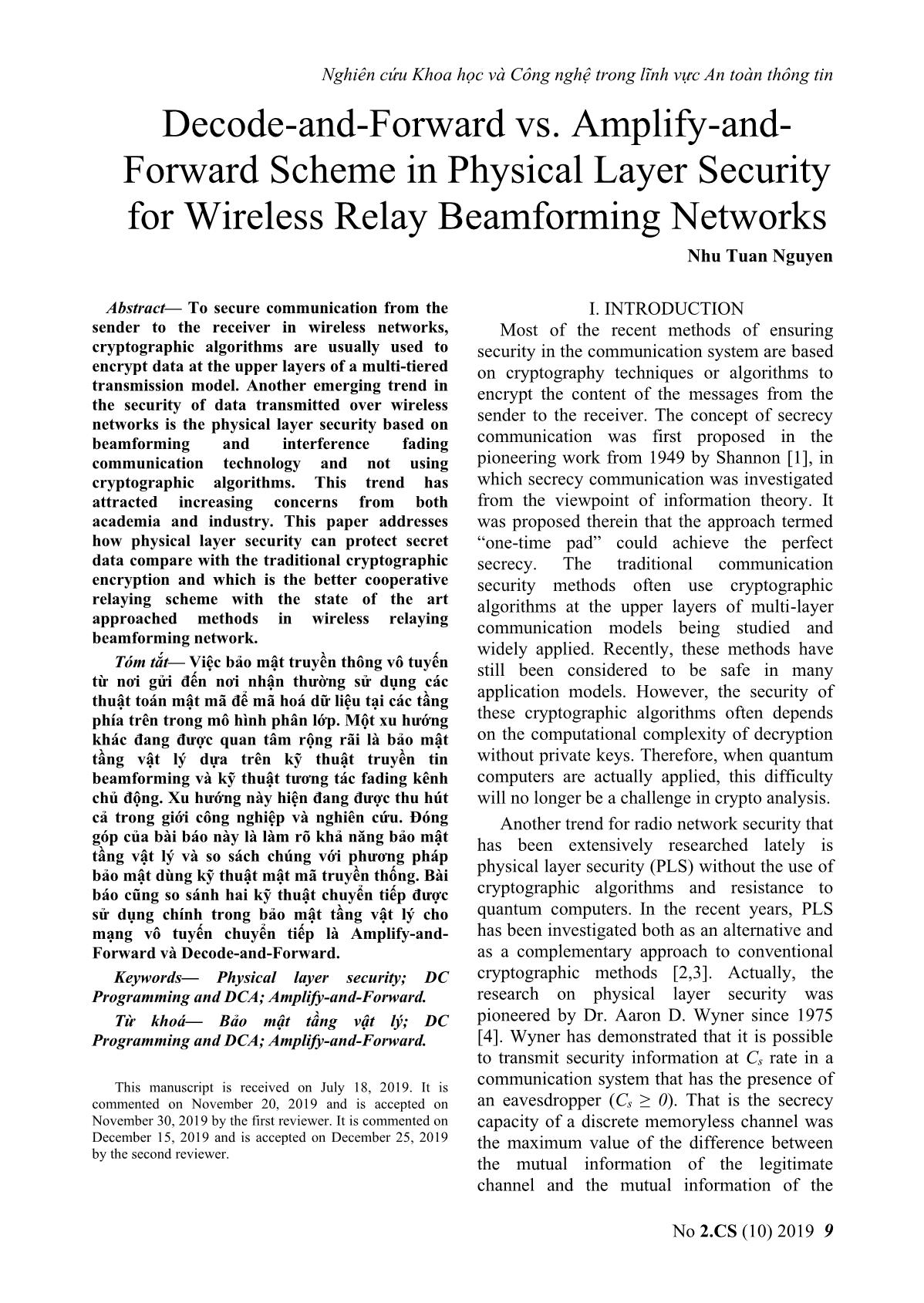
Trang 1
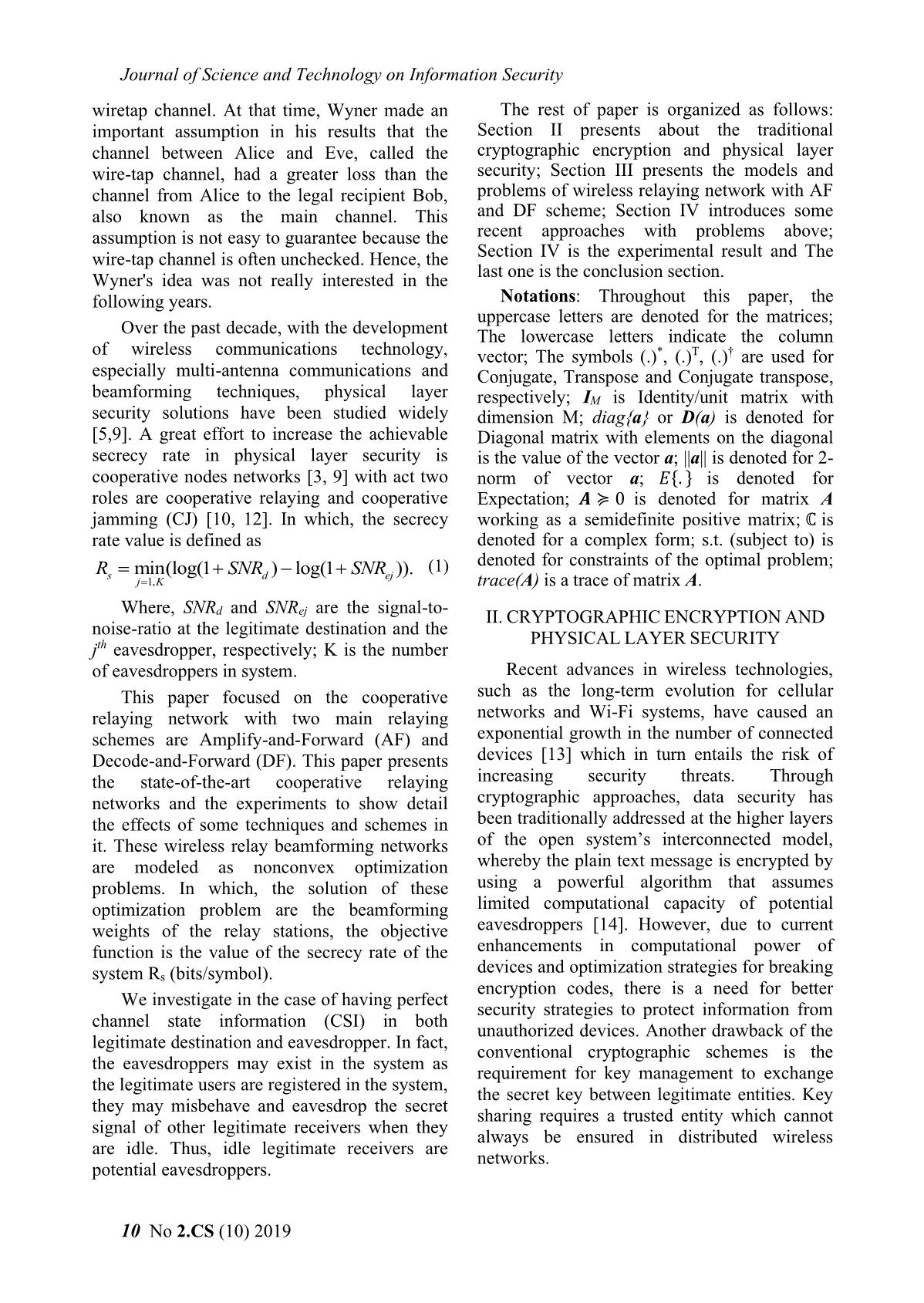
Trang 2
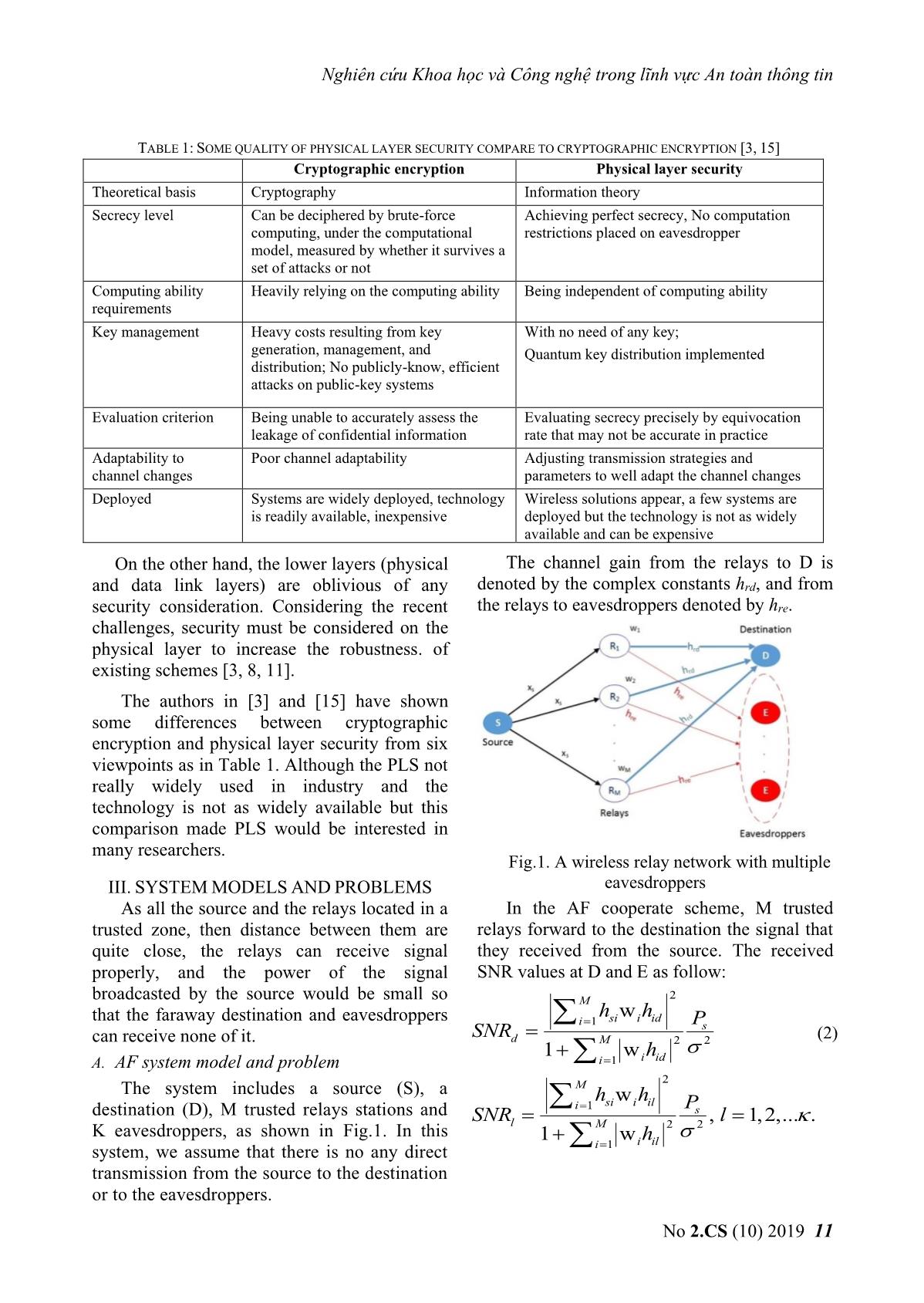
Trang 3

Trang 4
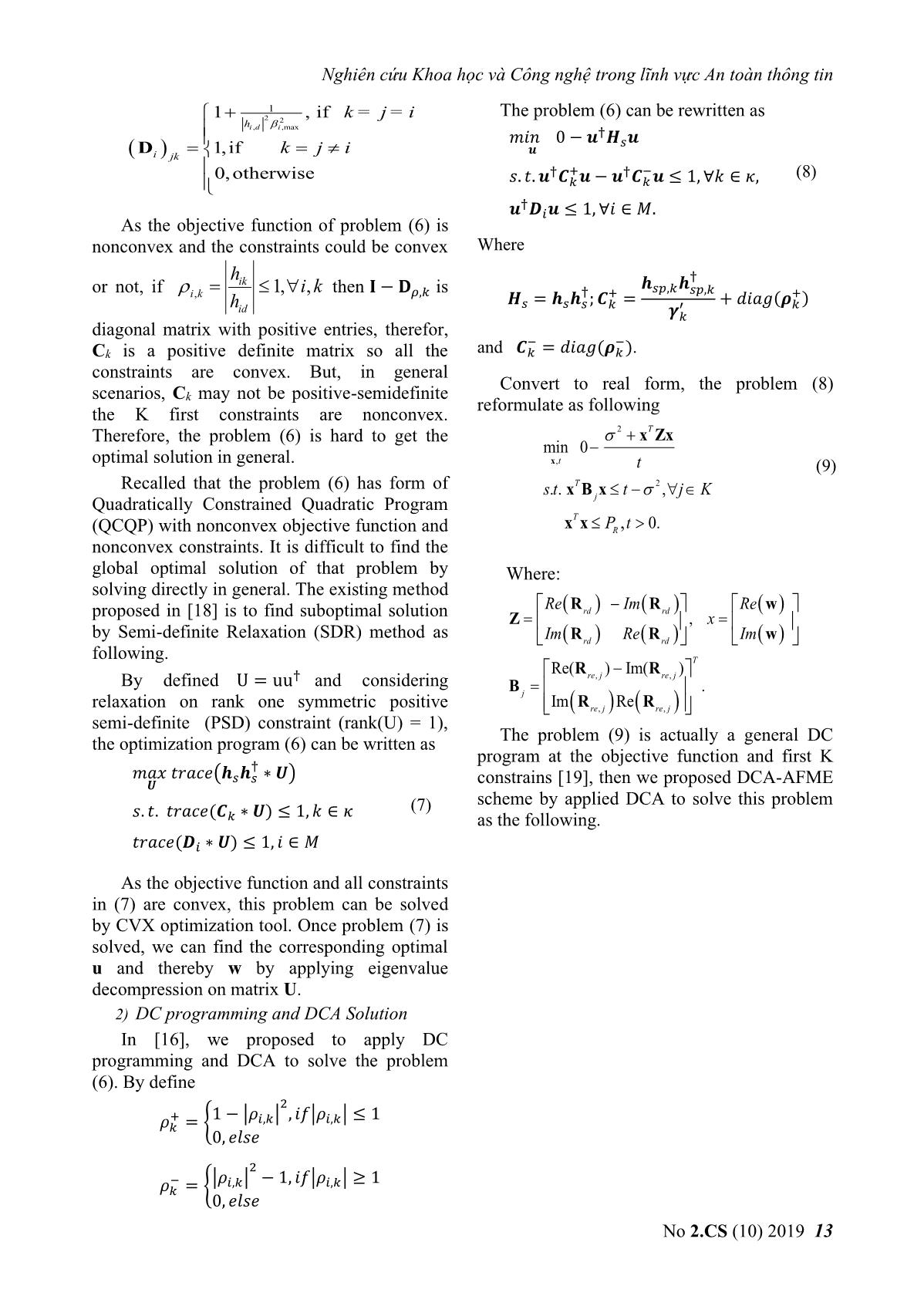
Trang 5
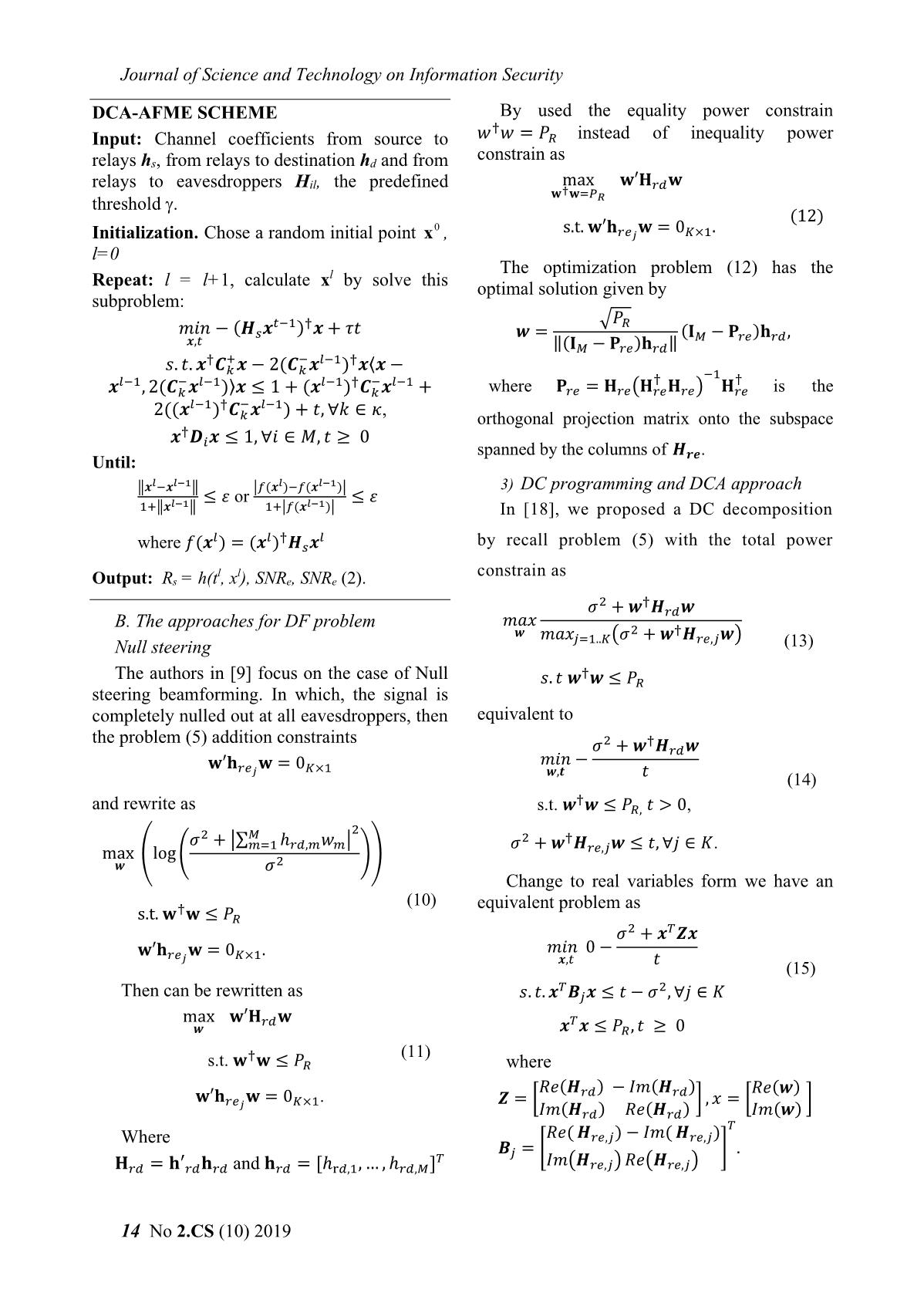
Trang 6
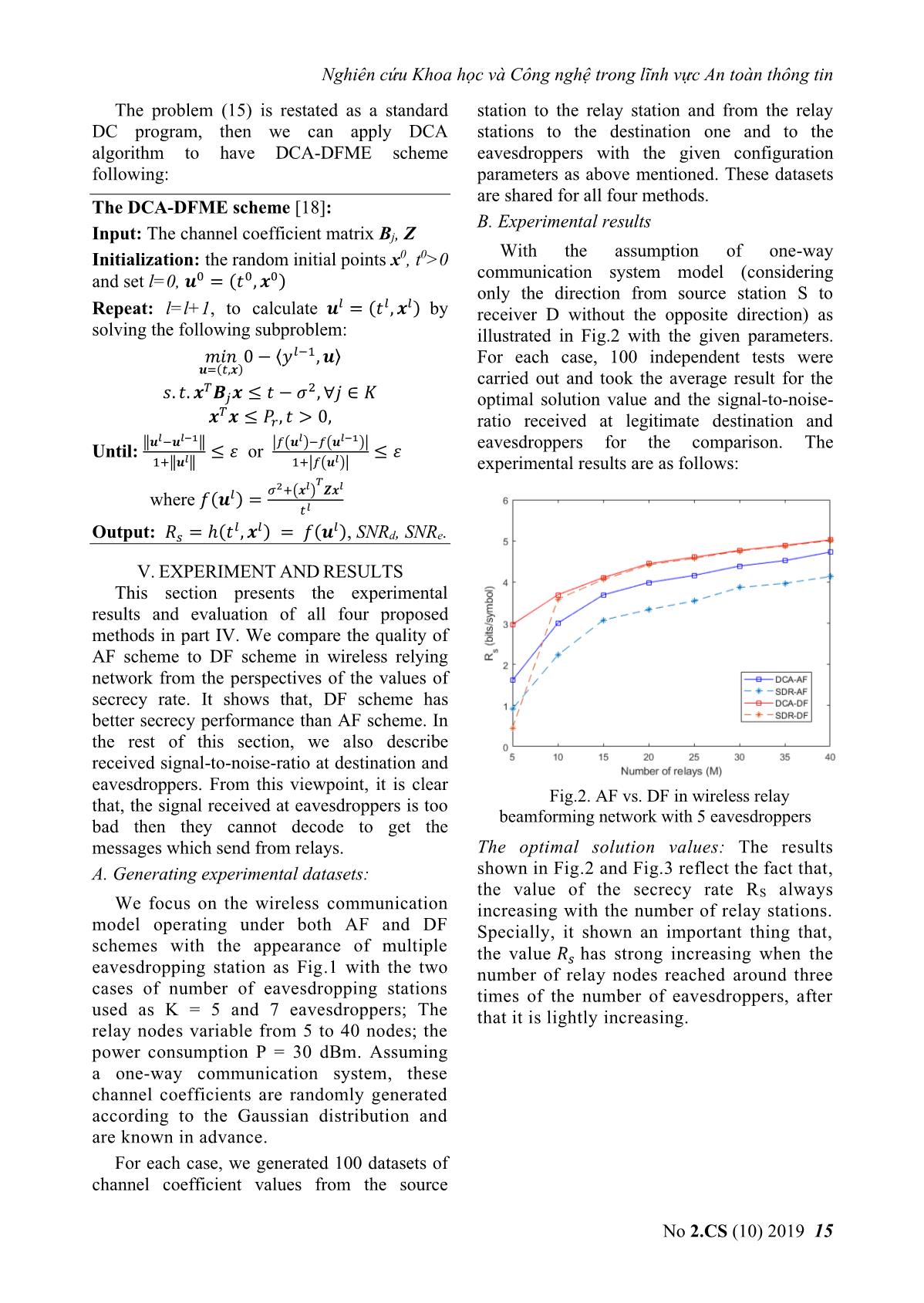
Trang 7
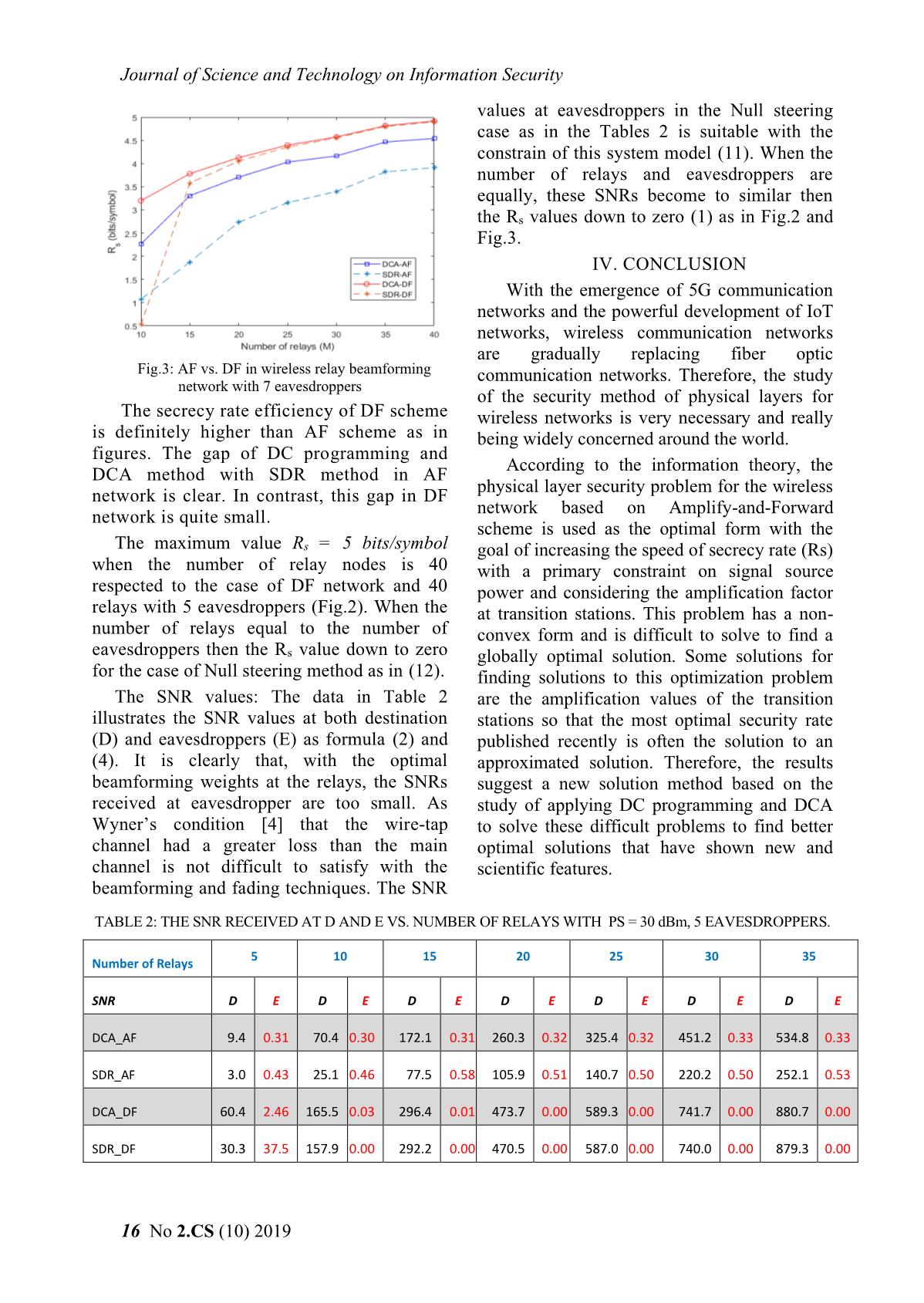
Trang 8
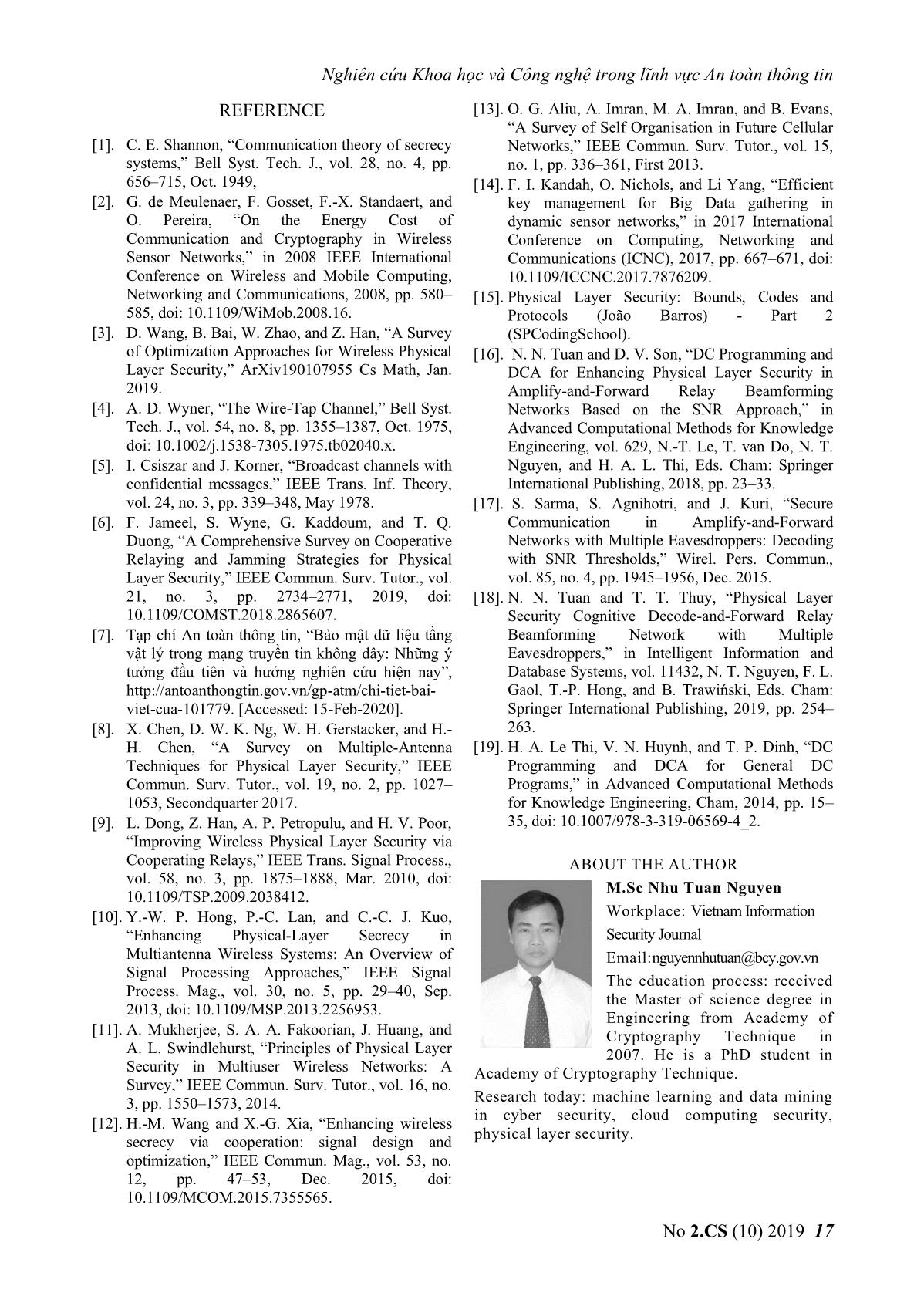
Trang 9
Tóm tắt nội dung tài liệu: Decode - And-forward vs. amplify - andforward scheme in physical layer security for wireless relay beamforming networks
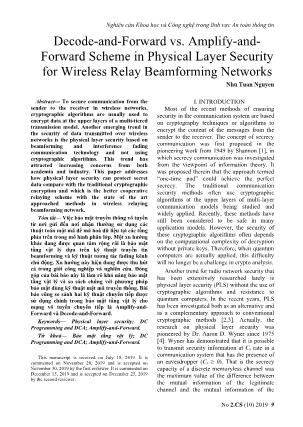
Nghiên cứu Khoa học và Công nghệ trong lĩnh vực An toàn thông tin No 2.CS (10) 2019 9 Decode-and-Forward vs. Amplify-and- Forward Scheme in Physical Layer Security for Wireless Relay Beamforming Networks Nhu Tuan Nguyen Abstract— To secure communication from the sender to the receiver in wireless networks, cryptographic algorithms are usually used to encrypt data at the upper layers of a multi-tiered transmission model. Another emerging trend in the security of data transmitted over wireless networks is the physical layer security based on beamforming and interference fading communication technology and not using cryptographic algorithms. This trend has attracted increasing concerns from both academia and industry. This paper addresses how physical layer security can protect secret data compare with the traditional cryptographic encryption and which is the better cooperative relaying scheme with the state of the art approached methods in wireless relaying beamforming network. Tóm tắt— Việc bảo mật truyền thông vô tuyến từ nơi gửi đến nơi nhận thường sử dụng các thuật toán mật mã để mã hoá dữ liệu tại các tầng phía trên trong mô hình phân lớp. Một xu hướng khác đang được quan tâm rộng rãi là bảo mật tầng vật lý dựa trên kỹ thuật truyền tin beamforming và kỹ thuật tương tác fading kênh chủ động. Xu hướng này hiện đang được thu hút cả trong giới công nghiệp và nghiên cứu. Đóng góp của bài báo này là làm rõ khả năng bảo mật tầng vật lý và so sách chúng với phương pháp bảo mật dùng kỹ thuật mật mã truyền thống. Bài báo cũng so sánh hai kỹ thuật chuyển tiếp được sử dụng chính trong bảo mật tầng vật lý cho mạng vô tuyến chuyển tiếp là Amplify-and- Forward và Decode-and-Forward. Keywords— Physical layer security; DC Programming and DCA; Amplify-and-Forward. Từ khoá— Bảo mật tầng vật lý; DC Programming and DCA; Amplify-and-Forward. This manuscript is received on July 18, 2019. It is commented on November 20, 2019 and is accepted on November 30, 2019 by the first reviewer. It is commented on December 15, 2019 and is accepted on December 25, 2019 by the second reviewer. I. INTRODUCTION Most of the recent methods of ensuring security in the communication system are based on cryptography techniques or algorithms to encrypt the content of the messages from the sender to the receiver. The concept of secrecy communication was first proposed in the pioneering work from 1949 by Shannon [1], in which secrecy communication was investigated from the viewpoint of information theory. It was proposed therein that the approach termed “one-time pad” could achieve the perfect secrecy. The traditional communication security methods often use cryptographic algorithms at the upper layers of multi-layer communication models being studied and widely applied. Recently, these methods have still been considered to be safe in many application models. However, the security of these cryptographic algorithms often depends on the computational complexity of decryption without private keys. Therefore, when quantum computers are actually applied, this difficulty will no longer be a challenge in crypto analysis. Another trend for radio network security that has been extensively researched lately is physical layer security (PLS) without the use of cryptographic algorithms and resistance to quantum computers. In the recent years, PLS has been investigated both as an alternative and as a complementary approach to conventional cryptographic methods [2,3]. Actually, the research on physical layer security was pioneered by Dr. Aaron D. Wyner since 1975 [4]. Wyner has demonstrated that it is possible to transmit security information at Cs rate in a communication system that has the presence of an eavesdropper (Cs ≥ 0). That is the secrecy capacity of a discrete memoryless channel was the maximum value of the difference between the mutual information of the legitimate channel and the mutual information of the Journal of Science and Technology on Information Security 10 No 2.CS (10) 2019 wiretap channel. At that time, Wyner made an important assumption in his results that the channel between Alice and Eve, called the wire-tap channel, had a greater loss than the channel from Alice to the legal recipient Bob, also known as the main channel. This assumption is not easy to guarantee because the wire-tap channel is often unchecked. Hence, the Wyner's idea was not really interested in the following years. Over the past decade, with the development of wireless communications technology, especially multi-antenna communications and beamforming techniques, physical layer security solutions have been studied widely [5,9]. A great effort to increase the achievable secrecy rate in physical layer security is cooperative nodes networks [3, 9] with act two roles are cooperative relaying and cooperative jamming (CJ) [10, 12]. In which, the secrecy rate value is defined as 1, min(log(1 ) log(1 )).s d ej j K R SNR SNR = = + − + (1) Where, SNRd and SNRej are the signal-to- noise-ratio at the legitimate destination and the jth eavesdropper, respectively; K is the number of eavesdroppers in system. This paper focused on the cooperative relaying network with two main relaying schemes are Amplify-and-Forward (AF) and Decode-and-Forward (DF). This paper presents the state-of-the-art cooperative relaying networks and the experiments to show detail the effects of some techniques and schemes in it. These wireless relay beamforming networks are modeled as nonconvex optimization problems. In which, the solution of these optimization problem are the beamforming weights of the relay stations, the objective function is the value of the secrecy rate of the system Rs (bits/symbol). We investigate in the case ... constrains [19], then we proposed DCA-AFME scheme by applied DCA to solve this problem as the following. Journal of Science and Technology on Information Security 14 No 2.CS (10) 2019 DCA-AFME SCHEME Input: Channel coefficients from source to relays hs, from relays to destination hd and from relays to eavesdroppers Hil, the predefined threshold . Initialization. Chose a random initial point 0x , l=0 Repeat: l = l+1, calculate xl by solve this subproblem: 𝑚𝑖𝑛 𝒙,𝑡 − (𝑯𝑠𝒙 𝑡−1)†𝒙 + 𝜏𝑡 𝑠. 𝑡. 𝒙†𝑪𝑘 +𝒙 − 2(𝑪𝑘 −𝒙𝑙−1)†𝒙⟨𝒙 − 𝒙𝑙−1, 2(𝑪𝑘 −𝒙𝑙−1)⟩𝒙 ≤ 1 + (𝒙𝑙−1)†𝑪𝑘 −𝒙𝑙−1 + 2((𝒙𝑙−1)†𝑪𝑘 −𝒙𝑙−1) + 𝑡, ∀𝑘 ∈ 𝜅, 𝒙†𝑫𝑖𝒙 ≤ 1, ∀𝑖 ∈ 𝑀, 𝑡 ≥ 0 Until: ‖𝒙𝑙−𝒙𝑙−1‖ 1+‖𝒙𝑙−1‖ ≤ 𝜀 or |𝑓(𝒙𝑙)−𝑓(𝒙𝑙−1)| 1+|𝑓(𝒙𝑙−1)| ≤ 𝜀 where 𝑓(𝒙𝑙) = (𝒙𝑙)†𝑯𝑠𝒙 𝑙 Output: Rs = h(t l, xl), SNRe, SNRe (2). B. The approaches for DF problem Null steering The authors in [9] focus on the case of Null steering beamforming. In which, the signal is completely nulled out at all eavesdroppers, then the problem (5) addition constraints 𝐰′𝐡𝑟𝑒𝑗𝐰 = 0𝐾×1 and rewrite as max 𝒘 (log ( 𝜎2 + |∑ ℎ𝑟𝑑,𝑚𝑤𝑚 𝑀 𝑚=1 | 2 𝜎2 )) s.t. 𝐰†𝐰 ≤ 𝑃𝑅 𝐰′𝐡𝑟𝑒𝑗𝐰 = 0𝐾×1. (10) Then can be rewritten as max 𝒘 𝐰′𝐇𝑟𝑑𝐰 s.t. 𝐰†𝐰 ≤ 𝑃𝑅 𝐰′𝐡𝑟𝑒𝑗𝐰 = 0𝐾×1. (11) Where 𝐇𝑟𝑑 = 𝐡′𝑟𝑑𝐡𝑟𝑑 and 𝐡𝑟𝑑 = [ℎr𝑑,1, , ℎ𝑟𝑑,𝑀] 𝑇 By used the equality power constrain 𝑤†𝑤 = 𝑃𝑅 instead of inequality power constrain as max 𝐰†𝐰=𝑃𝑅 𝐰′𝐇𝑟𝑑𝐰 s.t. 𝐰′𝐡𝑟𝑒𝑗𝐰 = 0𝐾×1. (12) The optimization problem (12) has the optimal solution given by 𝒘 = √𝑃𝑅 ‖(𝐈𝑀 − 𝐏𝑟𝑒)𝐡𝑟𝑑‖ (𝐈𝑀 − 𝐏𝑟𝑒)𝐡𝑟𝑑 , where 𝐏𝑟𝑒 = 𝐇𝑟𝑒(𝐇𝑟𝑒 † 𝐇𝑟𝑒) −1 𝐇𝑟𝑒 † is the orthogonal projection matrix onto the subspace spanned by the columns of 𝑯𝒓𝒆. 3) DC programming and DCA approach In [18], we proposed a DC decomposition by recall problem (5) with the total power constrain as 𝑚𝑎𝑥 𝒘 𝜎2 + 𝒘†𝑯𝑟𝑑𝒘 𝑚𝑎𝑥𝑗=1..𝐾(𝜎2 + 𝒘†𝑯𝑟𝑒,𝑗𝒘) 𝑠. 𝑡 𝒘†𝒘 ≤ 𝑃𝑅 (13) equivalent to 𝑚𝑖𝑛 𝒘,𝒕 − 𝜎2 + 𝒘†𝑯𝑟𝑑𝒘 𝑡 s.t. 𝒘†𝒘 ≤ 𝑃𝑅, 𝑡 > 0, 𝜎2 + 𝒘†𝑯𝑟𝑒,𝑗𝒘 ≤ 𝑡, ∀𝑗 ∈ 𝐾. (14) Change to real variables form we have an equivalent problem as 𝑚𝑖𝑛 𝒙,𝑡 0 − 𝜎2 + 𝒙𝑇𝒁𝒙 𝑡 𝑠. 𝑡. 𝒙𝑇𝑩𝑗𝒙 ≤ 𝑡 − 𝜎 2, ∀𝑗 ∈ 𝐾 𝒙𝑇𝒙 ≤ 𝑃𝑅 , 𝑡 ≥ 0 (15) where 𝒁 = [ 𝑅𝑒(𝑯𝑟𝑑) − 𝐼𝑚(𝑯𝑟𝑑) 𝐼𝑚(𝑯𝑟𝑑) 𝑅𝑒(𝑯𝑟𝑑) ] , 𝑥 = [ 𝑅𝑒(𝒘) 𝐼𝑚(𝒘) ] 𝑩𝑗 = [ 𝑅𝑒( 𝑯𝑟𝑒,𝑗) − 𝐼𝑚( 𝑯𝑟𝑒,𝑗) 𝐼𝑚(𝑯𝑟𝑒,𝑗) 𝑅𝑒(𝑯𝑟𝑒,𝑗) ] 𝑇 . Nghiên cứu Khoa học và Công nghệ trong lĩnh vực An toàn thông tin No 2.CS (10) 2019 15 The problem (15) is restated as a standard DC program, then we can apply DCA algorithm to have DCA-DFME scheme following: The DCA-DFME scheme [18]: Input: The channel coefficient matrix Bj, Z Initialization: the random initial points x0, t0>0 and set l=0, 𝒖0 = (𝑡0, 𝒙0) Repeat: l=l+1, to calculate 𝒖𝑙 = (𝑡𝑙 , 𝒙𝑙) by solving the following subproblem: 𝑚𝑖𝑛 𝒖=(𝑡,𝒙) 0 − ⟨𝑦𝑙−1, 𝒖⟩ 𝑠. 𝑡. 𝒙𝑇𝑩𝑗𝒙 ≤ 𝑡 − 𝜎 2, ∀𝑗 ∈ 𝐾 𝒙𝑇𝒙 ≤ 𝑃𝑟, 𝑡 > 0, Until: ‖𝒖𝑙−𝒖𝑙−1‖ 1+‖𝒖𝑙‖ ≤ 𝜀 or |𝑓(𝒖𝑙)−𝑓(𝒖𝑙−1)| 1+|𝑓(𝒖𝑙)| ≤ 𝜀 where 𝑓(𝒖𝑙) = 𝜎2+(𝒙𝑙) 𝑇 𝒁𝒙𝑙 𝑡𝑙 Output: 𝑅𝑠 = ℎ(𝑡 𝑙 , 𝒙𝑙) = 𝑓(𝒖𝑙), SNRd, SNRe. V. EXPERIMENT AND RESULTS This section presents the experimental results and evaluation of all four proposed methods in part IV. We compare the quality of AF scheme to DF scheme in wireless relying network from the perspectives of the values of secrecy rate. It shows that, DF scheme has better secrecy performance than AF scheme. In the rest of this section, we also describe received signal-to-noise-ratio at destination and eavesdroppers. From this viewpoint, it is clear that, the signal received at eavesdroppers is too bad then they cannot decode to get the messages which send from relays. A. Generating experimental datasets: We focus on the wireless communication model operating under both AF and DF schemes with the appearance of multiple eavesdropping station as Fig.1 with the two cases of number of eavesdropping stations used as K = 5 and 7 eavesdroppers; The relay nodes variable from 5 to 40 nodes; the power consumption P = 30 dBm. Assuming a one-way communication system, these channel coefficients are randomly generated according to the Gaussian distribution and are known in advance. For each case, we generated 100 datasets of channel coefficient values from the source station to the relay station and from the relay stations to the destination one and to the eavesdroppers with the given configuration parameters as above mentioned. These datasets are shared for all four methods. B. Experimental results With the assumption of one-way communication system model (considering only the direction from source station S to receiver D without the opposite direction) as illustrated in Fig.2 with the given parameters. For each case, 100 independent tests were carried out and took the average result for the optimal solution value and the signal-to-noise- ratio received at legitimate destination and eavesdroppers for the comparison. The experimental results are as follows: Fig.2. AF vs. DF in wireless relay beamforming network with 5 eavesdroppers The optimal solution values: The results shown in Fig.2 and Fig.3 reflect the fact that, the value of the secrecy rate RS always increasing with the number of relay stations. Specially, it shown an important thing that, the value 𝑅𝑠 has strong increasing when the number of relay nodes reached around three times of the number of eavesdroppers, after that it is lightly increasing. Journal of Science and Technology on Information Security 16 No 2.CS (10) 2019 Fig.3: AF vs. DF in wireless relay beamforming network with 7 eavesdroppers The secrecy rate efficiency of DF scheme is definitely higher than AF scheme as in figures. The gap of DC programming and DCA method with SDR method in AF network is clear. In contrast, this gap in DF network is quite small. The maximum value Rs = 5 bits/symbol when the number of relay nodes is 40 respected to the case of DF network and 40 relays with 5 eavesdroppers (Fig.2). When the number of relays equal to the number of eavesdroppers then the Rs value down to zero for the case of Null steering method as in (12). The SNR values: The data in Table 2 illustrates the SNR values at both destination (D) and eavesdroppers (E) as formula (2) and (4). It is clearly that, with the optimal beamforming weights at the relays, the SNRs received at eavesdropper are too small. As Wyner’s condition [4] that the wire-tap channel had a greater loss than the main channel is not difficult to satisfy with the beamforming and fading techniques. The SNR values at eavesdroppers in the Null steering case as in the Tables 2 is suitable with the constrain of this system model (11). When the number of relays and eavesdroppers are equally, these SNRs become to similar then the Rs values down to zero (1) as in Fig.2 and Fig.3. IV. CONCLUSION With the emergence of 5G communication networks and the powerful development of IoT networks, wireless communication networks are gradually replacing fiber optic communication networks. Therefore, the study of the security method of physical layers for wireless networks is very necessary and really being widely concerned around the world. According to the information theory, the physical layer security problem for the wireless network based on Amplify-and-Forward scheme is used as the optimal form with the goal of increasing the speed of secrecy rate (Rs) with a primary constraint on signal source power and considering the amplification factor at transition stations. This problem has a non- convex form and is difficult to solve to find a globally optimal solution. Some solutions for finding solutions to this optimization problem are the amplification values of the transition stations so that the most optimal security rate published recently is often the solution to an approximated solution. Therefore, the results suggest a new solution method based on the study of applying DC programming and DCA to solve these difficult problems to find better optimal solutions that have shown new and scientific features. TABLE 2: THE SNR RECEIVED AT D AND E VS. NUMBER OF RELAYS WITH PS = 30 dBm, 5 EAVESDROPPERS. Number of Relays 5 10 15 20 25 30 35 SNR D E D E D E D E D E D E D E DCA_AF 9.4 0.31 70.4 0.30 172.1 0.31 260.3 0.32 325.4 0.32 451.2 0.33 534.8 0.33 SDR_AF 3.0 0.43 25.1 0.46 77.5 0.58 105.9 0.51 140.7 0.50 220.2 0.50 252.1 0.53 DCA_DF 60.4 2.46 165.5 0.03 296.4 0.01 473.7 0.00 589.3 0.00 741.7 0.00 880.7 0.00 SDR_DF 30.3 37.5 157.9 0.00 292.2 0.00 470.5 0.00 587.0 0.00 740.0 0.00 879.3 0.00 Nghiên cứu Khoa học và Công nghệ trong lĩnh vực An toàn thông tin No 2.CS (10) 2019 17 REFERENCE [1]. C. E. Shannon, “Communication theory of secrecy systems,” Bell Syst. Tech. J., vol. 28, no. 4, pp. 656–715, Oct. 1949, [2]. G. de Meulenaer, F. Gosset, F.-X. Standaert, and O. Pereira, “On the Energy Cost of Communication and Cryptography in Wireless Sensor Networks,” in 2008 IEEE International Conference on Wireless and Mobile Computing, Networking and Communications, 2008, pp. 580– 585, doi: 10.1109/WiMob.2008.16. [3]. D. Wang, B. Bai, W. Zhao, and Z. Han, “A Survey of Optimization Approaches for Wireless Physical Layer Security,” ArXiv190107955 Cs Math, Jan. 2019. [4]. A. D. Wyner, “The Wire-Tap Channel,” Bell Syst. Tech. J., vol. 54, no. 8, pp. 1355–1387, Oct. 1975, doi: 10.1002/j.1538-7305.1975.tb02040.x. [5]. I. Csiszar and J. Korner, “Broadcast channels with confidential messages,” IEEE Trans. Inf. Theory, vol. 24, no. 3, pp. 339–348, May 1978. [6]. F. Jameel, S. Wyne, G. Kaddoum, and T. Q. Duong, “A Comprehensive Survey on Cooperative Relaying and Jamming Strategies for Physical Layer Security,” IEEE Commun. Surv. Tutor., vol. 21, no. 3, pp. 2734–2771, 2019, doi: 10.1109/COMST.2018.2865607. [7]. Tạp chí An toàn thông tin, “Bảo mật dữ liệu tầng vật lý trong mạng truyền tin không dây: Những ý tưởng đầu tiên và hướng nghiên cứu hiện nay”, viet-cua-101779. [Accessed: 15-Feb-2020]. [8]. X. Chen, D. W. K. Ng, W. H. Gerstacker, and H.- H. Chen, “A Survey on Multiple-Antenna Techniques for Physical Layer Security,” IEEE Commun. Surv. Tutor., vol. 19, no. 2, pp. 1027– 1053, Secondquarter 2017. [9]. L. Dong, Z. Han, A. P. Petropulu, and H. V. Poor, “Improving Wireless Physical Layer Security via Cooperating Relays,” IEEE Trans. Signal Process., vol. 58, no. 3, pp. 1875–1888, Mar. 2010, doi: 10.1109/TSP.2009.2038412. [10]. Y.-W. P. Hong, P.-C. Lan, and C.-C. J. Kuo, “Enhancing Physical-Layer Secrecy in Multiantenna Wireless Systems: An Overview of Signal Processing Approaches,” IEEE Signal Process. Mag., vol. 30, no. 5, pp. 29–40, Sep. 2013, doi: 10.1109/MSP.2013.2256953. [11]. A. Mukherjee, S. A. A. Fakoorian, J. Huang, and A. L. Swindlehurst, “Principles of Physical Layer Security in Multiuser Wireless Networks: A Survey,” IEEE Commun. Surv. Tutor., vol. 16, no. 3, pp. 1550–1573, 2014. [12]. H.-M. Wang and X.-G. Xia, “Enhancing wireless secrecy via cooperation: signal design and optimization,” IEEE Commun. Mag., vol. 53, no. 12, pp. 47–53, Dec. 2015, doi: 10.1109/MCOM.2015.7355565. [13]. O. G. Aliu, A. Imran, M. A. Imran, and B. Evans, “A Survey of Self Organisation in Future Cellular Networks,” IEEE Commun. Surv. Tutor., vol. 15, no. 1, pp. 336–361, First 2013. [14]. F. I. Kandah, O. Nichols, and Li Yang, “Efficient key management for Big Data gathering in dynamic sensor networks,” in 2017 International Conference on Computing, Networking and Communications (ICNC), 2017, pp. 667–671, doi: 10.1109/ICCNC.2017.7876209. [15]. Physical Layer Security: Bounds, Codes and Protocols (João Barros) - Part 2 (SPCodingSchool). [16]. N. N. Tuan and D. V. Son, “DC Programming and DCA for Enhancing Physical Layer Security in Amplify-and-Forward Relay Beamforming Networks Based on the SNR Approach,” in Advanced Computational Methods for Knowledge Engineering, vol. 629, N.-T. Le, T. van Do, N. T. Nguyen, and H. A. L. Thi, Eds. Cham: Springer International Publishing, 2018, pp. 23–33. [17]. S. Sarma, S. Agnihotri, and J. Kuri, “Secure Communication in Amplify-and-Forward Networks with Multiple Eavesdroppers: Decoding with SNR Thresholds,” Wirel. Pers. Commun., vol. 85, no. 4, pp. 1945–1956, Dec. 2015. [18]. N. N. Tuan and T. T. Thuy, “Physical Layer Security Cognitive Decode-and-Forward Relay Beamforming Network with Multiple Eavesdroppers,” in Intelligent Information and Database Systems, vol. 11432, N. T. Nguyen, F. L. Gaol, T.-P. Hong, and B. Trawiński, Eds. Cham: Springer International Publishing, 2019, pp. 254– 263. [19]. H. A. Le Thi, V. N. Huynh, and T. P. Dinh, “DC Programming and DCA for General DC Programs,” in Advanced Computational Methods for Knowledge Engineering, Cham, 2014, pp. 15– 35, doi: 10.1007/978-3-319-06569-4_2. ABOUT THE AUTHOR M.Sc Nhu Tuan Nguyen Workplace: Vietnam Information Security Journal Email:nguyennhutuan@bcy.gov.vn The education process: received the Master of science degree in Engineering from Academy of Cryptography Technique in 2007. He is a PhD student in Academy of Cryptography Technique. Research today: machine learning and data mining in cyber security, cloud computing security, physical layer security.
File đính kèm:
 decode_and_forward_vs_amplify_andforward_scheme_in_physical.pdf
decode_and_forward_vs_amplify_andforward_scheme_in_physical.pdf

